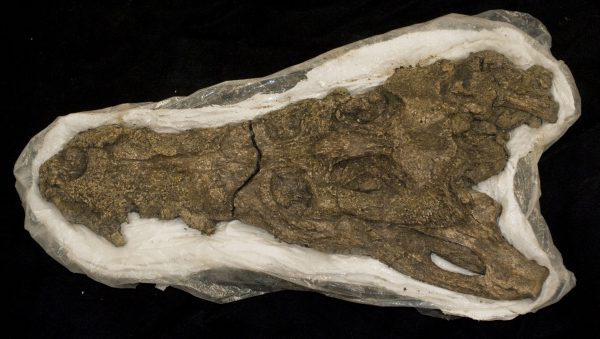A 60-million-year-old relative of crocodiles described this week by University of Florida researchers in the Journal of Vertebrate Paleontology was likely a food source for Titanoboa, the largest snake the world has ever known.
Working with scientists from the Smithsonian Tropical Research Institute in Panama, paleontologists from the Florida Museum of Natural History on the UF campus found fossils of the new species of ancient crocodile in the Cerrejon Formation in northern Colombia. The site, one of the world’s largest open-pit coal mines, also yielded skeletons of the giant, boa constrictor-like Titanoboa, which measured up to 45 feet long. The study is the first report of a fossil crocodyliform from the same site.
“We’re starting to flesh out the fauna that we have from there,” said lead author Alex Hastings, a graduate student at the Florida Museum and UF’s department of geological sciences.

Specimens used in the study show the new species, named Cerrejonisuchus improcerus, grew only 6 to 7 feet long, making it easy prey for Titanoboa. Its scientific name means small crocodile from Cerrejon.
The findings follow another study by researchers at UF and the Smithsonian providing the first reliable evidence of what Neotropical rainforests looked like 60 million years ago.
While Cerrejonisuchus is not directly related to modern crocodiles, it played an important role in the early evolution of South American rainforest ecosystems, said Jonathan Bloch, a Florida Museum vertebrate paleontologist and associate curator.
“Clearly this new fossil would have been part of the food-chain, both as predator and prey,” said Bloch, who co-led the fossil-hunting expeditions to Cerrejon with Smithsonian paleobotanist Carlos Jaramillo. “Giant snakes today are known to eat crocodylians, and it is not much of a reach to say Cerrejonisuchus would have been a frequent meal for Titanoboa. Fossils of the two are often found side-by-side.”
The concept of ancient crocodyliforms as snake food has its parallel in the modern world, as anacondas have been documented consuming caimans in the Amazon. Given the ancient reptile’s size, it would have been no competition for Titanoboa, Hastings said.
Cerrejonisuchus improcerus is the smallest member of Dyrosauridae, a family of now-extinct crocodyliforms. Dyrosaurids typically grew to about 18 feet and had long tweezer-like snouts for eating fish. By contrast, the Cerrejon species had a much shorter snout, indicating a more generalized diet that likely included frogs, lizards, small snakes and possibly mammals.
“It seems that Cerrejonisuchus managed to tap into a feeding resource that wasn’t useful to other larger crocodyliforms,” Hastings said.
The study reveals an unexpected level of diversity among dyrosaurids, said Christopher A. Brochu, a paleontologist and associate professor in geosciences at the University of Iowa.
“This diversity is more evolutionarily complex than expected,” said Brochu, who was not involved in the study. “A limited number of snout shapes evolved repeatedly in many groups of crocodyliforms, and it appears that the same is true for dyrosaurids. Certain head shapes arose in different dyrosaurid lineages independently.”
Dyrosaurids split from the branch that eventually produced the modern families of alligators and crocodiles more than 100 million years ago. They survived the major extinction event that killed the dinosaurs but eventually went extinct about 45 million years ago. Most dyrosaurids have been found in Africa, but they occur throughout the world. Prior to this finding, only one other dyrosaurid skull from South America had been described.
Scientists previously believed dyrosaurids diversified in the Paleogene, the period of time following the mass extinction of dinosaurs, but this study reinforces the view that much of their diversity was in place before the mass extinction event, Brochu said. Somehow dyrosaurids survived the mass extinction intact while other marine reptile groups, such as mosasaurs and plesiosaurs, died out completely.
The crocodyliform’s diminutive size came as a surprise, Hastings said, especially considering the giant reptiles that lived during the Late Cretaceous. The fossil record also points to the possibility of other types of ancient crocodyliforms inhabiting the same ecosystem. “In a lot of these tropical, diverse ecosystems in which crocodyliforms can thrive, you often see multiple snout types,” he said. “They tend to start speciating into different groups.”
Learn more about the Vertebrate Paleontology Collection at the Florida Museum.